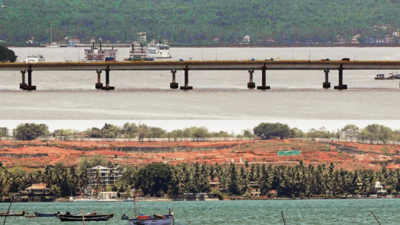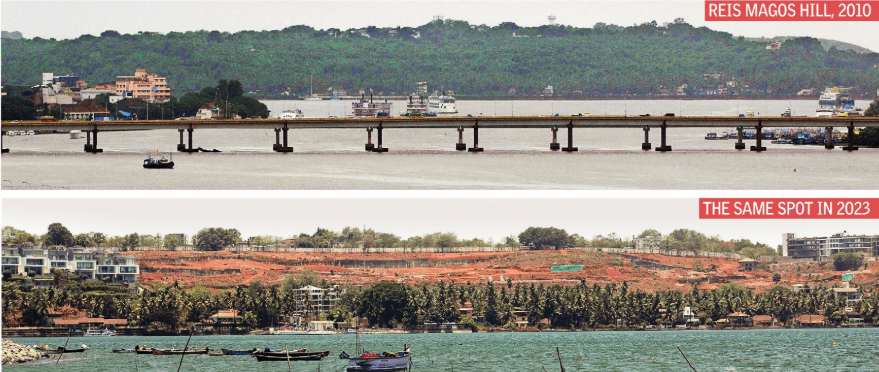ARTICLE AD BOX

Goa's hills are vanishing due to rampant, unregulated cutting for real estate, sparking ecological concerns and increasing disaster risks
Illegal flattening of hills for real estate projects is not only changing the character of India’s tiniest state, but is also pushing it towards ecological disasterGoa’s lush green hills and verdant landscape — some of the defining characteristics of India’s tiniest state — are in danger of being relegated to sepia-tinted memories, thanks to unregulated razing of hills in areas that are now deemed to have high real estate value.
From the fast-urbanising hills of Siolim and Mayem to the once green slopes of Cuncolim and Loliem, Goa’s hills have been steadily gouged and flattened, often illegally. And little has been done about it.As the state barrels towards a construction-heavy future, experts warn that this practice, if left unchecked, threatens not just its fragile ecology, but also traditional village landscapes. It would also make parts of the state prone to natural disasters, like last year’s devastating landslide in Kerala’s Wayanad, which claimed 254 lives and injured nearly 400.

It is not as if these hill cuttings have gone unnoticed. Data provided by the town and country planning (TCP) department paint a stark picture of the ravages suffered. There have been around 1,050 complaints of hill-cutting and land-filling over the past five years, with 754 cases of hill cutting being reported to the department in the last two years alone.Complaints pouring in from villagesAccording to data tabled by the TCP department in the state assembly, 534 complaints of hill cutting and land filling originated from Bardez, with complaints also pouring in from villages deemed to be high-value real estate, such as Reis Magos, Assagao, Parra, Anjuna, Siolim, Calangute, Pomburpa and Camurlim.
The hills of Bardez were carved out in 183 locations, but apart from just a complaint lodged, nothing was done.

In nearly nine out of 10 cases, the department’s standard response was a flat “Informed PI of police station concerned to investigate the matter.” While instructions were issued to file FIRs in some cases, no action was taken to restore the hills and impose steep fines on violators.“This uniformity in response, without evidence of further action, raises questions about the efficacy of enforcement mechanisms,” a former bureaucrat says. A TCP department official said the data did not include complaints directly filed with other authorities, such as collectors, the environment department and police. The department has records of just six instances of damaged hills being restored. Very often, restoration work has remained pending with the office of the deputy collector.“The actual number of hill-cutting violations is much higher,” says environmentalist Abhijit Prabhudesai, who’s also general secretary of Federation of Rainbow Warriors (FRW), a group of concerned citizens who have banded together to fight against environmental destruction and projects that threaten the state’s natural resources.“These numbers only reflect where a complaint was filed and the flying squad came for inspection. There are instances where either the complaint was not recorded due to political influence, or because it was for a govt project or even because the flying squad never showed up. In Poinguinim and Loliem itself, we identified a dozen cases of hill-cutting, in which nothing was done by the authorities after the initial complaint,” Prabhudesai added.Destruction, largely unchecked

In some instances, the TCP department said it had sent letters to the Goa State Disaster Management Authority to “do restoration” work on the hills. FIRs have also been filed in several instances, while PWD was directed to do balance restoration work. “Rule of law has completely collapsed,” says Prabhudesai. “People are cutting hills and filling fields as they wish. The situation has never been as bad in terms of enforcement.
There has not been even one instance of thesquad seizing equipment, or where restoration has been carried out.”Despite rampant hill-cutting, the destruction has gone largely unchecked. In South Goa, Salcete accounts for most complaints, with Cuncolim, Guirdolim, Verna and Paroda featuring on the list. Ponda, Canacona and Mormugao have also not been left untouched.The number of complaints is very conservative, says Claude Alvares, director of Goa Foundation, an environmental action group founded in 1986 by a group of Goan environmentalists.
“Many people don’t file complaints because they know that nothing happens,” he adds.‘Needed: A blanket ban on construction’It was the Wayanad disaster that forced CM Pramod Sawant to admit that widespread hill-cutting and uncontrolled development is taking place in the state. Sawant issued a diktat to local talathis (village accountants or revenue officers), asking them to monitor and report illegal hill-cutting under their jurisdictions.TCP minister Vishwajit Rane has promised to introduce stringent norms to curb hill-cutting and land-filling, but Alvares isn’t convinced. “Permissions for development and conversion of hillsunder Section 39A continue to be given by TCP,” he says. “The department’s power to issue permissions for the hills and slopes should be taken away. There should be a blanket ban on construction.”“Senior govt officials question why hill-cutting should be stopped, since climate change cannot be stopped. That is their attitude,” says Prabhudesai.In response to growing concerns over illegal hill-cutting, Goa govt has proposed stringent penalties — up to Rs 1 crore — for violations. “But the effectiveness of these measures hinges on robust enforcement and the political will to act against offenders,” says a revenue official.



.png)
.png)
.png)
















 1 day ago
4
1 day ago
4








 English (US) ·
English (US) ·